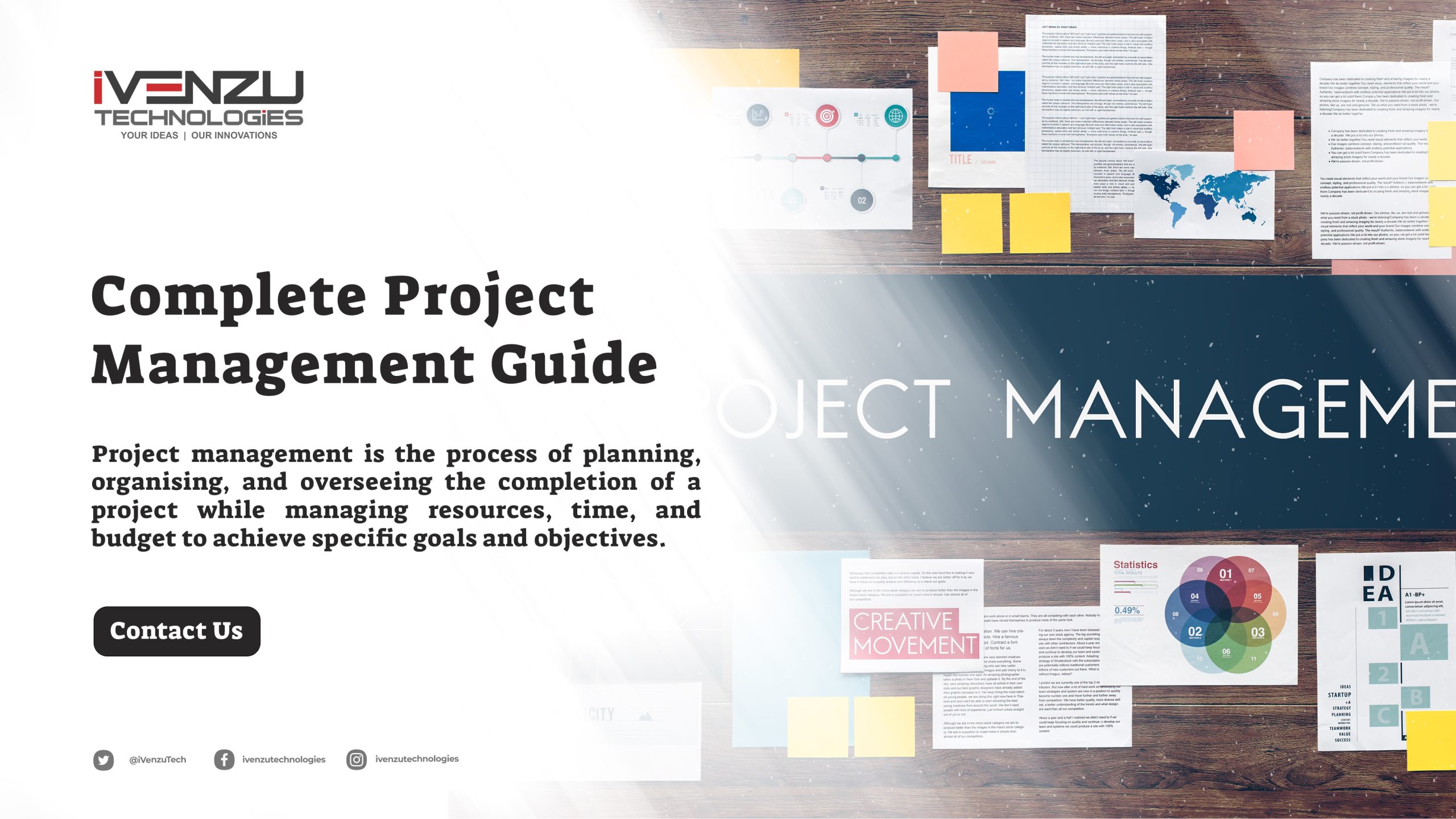Complete Project Management Guide: Best Practices, Tools, and Methodologies
Project management is the process of planning, organising, and overseeing the completion of a project while managing resources, time, and budget to achieve specific goals and objectives. Effective project management ensures that projects are completed on time, within budget, and to the satisfaction of stakeholders.

This comprehensive guide will walk you through the essential aspects of project management, including methodologies, tools, and techniques that can help you manage your projects efficiently and effectively. Whether you’re new to project management or an experienced manager looking to refine your skills, this guide will provide valuable insights.
Table of Contents
What is Project Management?
Key Phases of Project Management
-
-
- Initiation
- Planning
- Execution
- Monitoring and Controlling
- Closing
-
Types of Project Management Methodologies
-
-
- Waterfall
- Agile
- Scrum
- Kanban
- Lean
-
Project Management Tools
-
-
- Task Management Software
- Collaboration Tools
- Time Tracking Software
- Resource Management Tools
-
Project Management Best Practices
-
-
- Clear Objectives
- Risk Management
- Communication
- Stakeholder Management
- Regular Reviews
-
Challenges in Project Management
How to Become a Successful Project Manager
Conclusion
1. What is Project Management?
Project management involves applying knowledge, skills, tools, and techniques to project activities to meet project requirements. It encompasses several tasks, including defining project goals, planning tasks, assigning resources, tracking progress, and ensuring the project meets deadlines, within scope, and on budget.
Key Components of Project Management:
-
- Scope: Defining what is included in the project and what is not.
- Time: Managing timelines and deadlines.
- Cost: Ensuring the project stays within the budget.
- Quality: Meeting the project’s quality standards.
- Risk: Identifying potential risks and managing them.
- Resources: Managing human, financial, and material resources.
2. Key Phases of Project Management
Every project goes through several phases, from initial concept to project completion. These phases help manage the project efficiently and ensure its success.
Initiation
The project’s objectives, scope, and stakeholders are defined in the initiation phase. The project manager and key stakeholders outline the project’s purpose and importance.
Key Steps:
-
- Define the project scope.
- Identify stakeholders.
- Create a project charter.
Planning
Planning is the most crucial phase in project management. It involves creating a roadmap that outlines how the project will be completed, including timelines, resources, budgets, and tasks.
Key Steps:
-
- Set clear, measurable goals.
- Break down the project into smaller tasks.
- Define a schedule.
- Determine the resources and budget.
- Identify potential risks and create mitigation plans.
Execution
During the execution phase, the project plan is put into action. Resources are assigned, tasks are completed, and teams begin to work toward achieving the project goals.
Key Steps:
-
- Assign tasks and responsibilities.
- Coordinate teams and resources.
- Execute project activities.
- Monitor progress and ensure quality standards.
Monitoring and Controlling
In this phase, the project manager tracks the project’s progress to ensure it’s on track. This includes managing time, costs, and performance and making adjustments as needed.
Key Steps:
-
- Track progress against the project plan.
- Monitor resource allocation and usage.
- Identify and manage risks.
- Resolve issues and changes.
- Ensure the project is within scope, time, and budget.
Closing
The closing phase involves finalising all project activities. The team delivers the project to the client, completes all documentation, and evaluates the project’s overall success.
Key Steps:
-
- Provide Training If Required
- Finalise deliverables.
- Close contracts and agreements.
- Evaluate project performance and document lessons learned.
- Release project resources.
3. Types of Project Management Methodologies
There are various methodologies to manage projects, each suited for different types of projects and industries. The choice of methodology can affect how a project is planned, executed, and monitored.
Waterfall
Waterfall is a traditional, linear approach to project management where each phase is completed before the next one begins. It’s often used for projects with well-defined requirements and little need for change.
Agile/SafeAgile
Agile/SafeAgile focuses on flexibility, collaboration, and customer satisfaction. It uses iterative cycles, known as sprints, to develop and refine the project incrementally.
Scrum
Scrum is a specific Agile framework emphasising short, time-boxed development cycles (sprints), regular meetings (daily standups), and a collaborative team environment.
Kanban
Kanban focuses on visualising tasks on boards, managing workflow, and optimising efficiency. It’s highly adaptable and is used in many industries to maintain continuous improvement.
Lean
Lean project management minimises waste, optimises resources, and delivers value to customers. It’s commonly used in manufacturing and product development projects.
4. Project Management Tools
Project management tools help project managers streamline processes, track progress, and ensure effective communication among teams. Here are some essential types of tools:
Task Management Software
These tools help assign tasks, set deadlines, and track progress. Popular options include Trello, Asana, Jira and Monday.com.
Collaboration Tools
Communication is key to successful project management. Tools like Slack, Microsoft Teams, and Zoom help teams stay connected, share information, and collaborate effectively.
Time Tracking Software
Tools like Toggl and Harvest allow teams to track time spent on tasks and manage project budgets more effectively.
Resource Management Tools
These tools help allocate and track the use of resources. Resource Guru and LiquidPlanner are examples of tools designed to manage resources efficiently.
5. Project Management Best Practices
Project managers should adhere to best practices to ensure a project’s success. Here are some essential practices to follow:
Clear Objectives
Defining clear, measurable project goals ensures everyone is aligned and working toward the same outcome.
Risk Management
Identifying risks early and creating mitigation strategies is crucial for preventing project delays and budget overruns.
Effective Communication
Regular communication among stakeholders, team members, and clients ensures that everyone is informed and that any issues are addressed quickly.
Stakeholder Management
Managing expectations and maintaining positive relationships with stakeholders is key to project success.
Regular Reviews
Periodic project reviews ensure the project stays on track, allows for adjustments, and ensures alignment with goals.
6. Challenges in Project Management
Project management comes with its own set of challenges. Some common challenges include:
-
- Scope Creep: When the project’s scope expands beyond the original plan, leading to delays and increased costs.
- Resource Constraints: Limited resources (time, budget, or personnel) can hinder the project’s progress.
- Risk Management: Unforeseen risks can cause disruptions, especially when they are not properly identified early on.
- Communication Issues: Miscommunication or lack of transparency can lead to misunderstandings, delays, and mistakes.
7. How to Become a Successful Project Manager
Becoming a successful project manager requires a mix of technical knowledge, leadership skills, and practical experience. Here are some steps to help you succeed:
-
- Get Educated: Take courses and certifications in project management, such as PMP (Project Management Professional) or Agile/Scrum certifications.
- Develop Soft Skills: Strong communication, leadership, and problem-solving skills are crucial.
- Gain Experience: Start by managing small projects and gradually take on larger, more complex ones.
- Stay Organised: Effective project managers are organised, detail-oriented, and proactive in managing tasks and resources.
8. Conclusion
Project management is an essential skill for delivering successful projects. By understanding key phases, methodologies, and best practices, project managers can effectively lead their teams to meet goals, deadlines, and budgets. Whether managing small-scale projects or large, complex initiatives, mastering the art of project management will ensure that your projects are executed with precision and success.
Your questions and answered
Q1. What is project management and why is it important?
Project management is the structured process of leading a team to achieve specific goals within a set timeframe, budget, and scope. It’s crucial for delivering successful outcomes, maximizing efficiency, and ensuring stakeholder satisfaction.
Q2. What are the main phases of a project?
The five main project phases are: Initiation, Planning, Execution, Monitoring & Controlling, and Closing. Each phase plays a vital role in the project’s success.
Q3. Which project management methodology is best?
It depends on the project type. Agile and Scrum are ideal for flexible, iterative development, while Waterfall suits projects with fixed requirements. Kanban and Lean are great for continuous workflow and resource optimization.
Q4. What are the top tools used in project management?
Popular tools include Trello, Asana, Jira (for task management), Slack and Microsoft Teams (for communication), Toggl (for time tracking), and Resource Guru (for resource management).
Q5. How can I become a successful project manager?
Obtain relevant certifications (like PMP or Scrum Master), build experience with smaller projects, enhance your communication and leadership skills, and stay organized with the right tools.
Q6. What is scope creep and how do I manage it?
Scope creep refers to uncontrolled changes or growth in a project’s scope. You can manage it by setting clear objectives, getting stakeholder sign-offs, and regularly reviewing the scope throughout the project lifecycle.
Q7. What are common project management challenges?
Common challenges include unclear goals, resource limitations, scope creep, communication gaps, and unmanaged risks. Addressing these early with best practices ensures smoother execution.
More Latest Blog
In today’s digital advertising landscape, CPC (Cost-Per-Click) has become a core metric that every marketer, business owner, and advertiser must...
Quantum computing is an emerging technology that leverages the principles of quantum mechanics to solve problems practically impossible for...
With the ever-increasing reliance on technology, the role of an app developer has emerged as one of the most pivotal and sought-after positions in...
Magento is one of the most popular open-source platforms for developing robust, scalable, and feature-rich e-commerce websites. It provides many...




